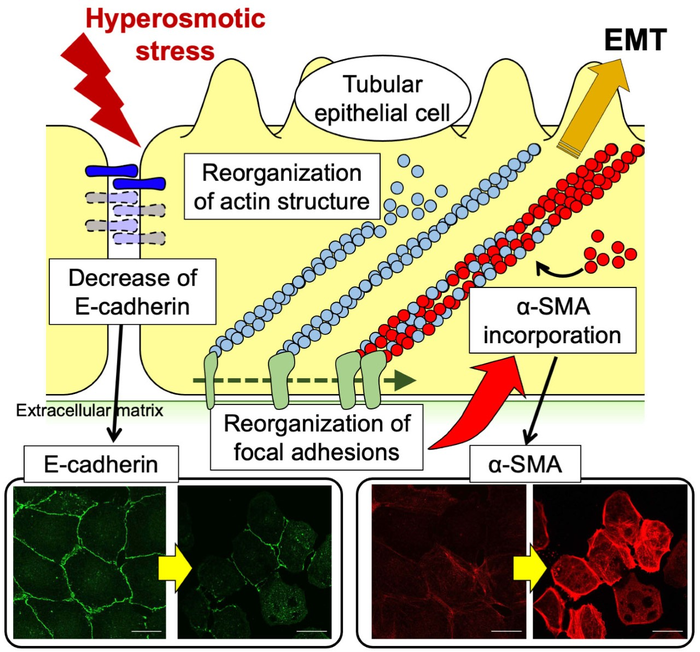Tokyo, Japan – Researchers from Tokyo Metropolitan University have uncovered the mechanism by which osmolytes used to treat high fluid pressure in the eye and skull can cause kidney damage. Using rat kidney cells treated with mannitol, they showed that certain kidney cells underwent a change in their skeletal structure, inducing a transformation that can lead to renal failure. They also found ways to arrest this change, suggesting new ways to avoid serious side effects.

Credit: Tokyo Metropolitan University
Tokyo, Japan – Researchers from Tokyo Metropolitan University have uncovered the mechanism by which osmolytes used to treat high fluid pressure in the eye and skull can cause kidney damage. Using rat kidney cells treated with mannitol, they showed that certain kidney cells underwent a change in their skeletal structure, inducing a transformation that can lead to renal failure. They also found ways to arrest this change, suggesting new ways to avoid serious side effects.
High pressure in the eye or the cranial fluid is a symptom of serious health problems and can cause tremendous damage. In the eye, ocular hypertension can lead to glaucoma and eventually permanent vision loss. Drugs used to treat this are often diuretics and come under a class of chemicals known as osmolytes. By dispersing into the blood, they come into contact with compartments of our body with too high a pressure, drawing out fluid and reducing the pressure. This includes mannitol, a common chemical given intravenously to tackle excess pressures in both the eye and brain. However, it is known that this lifesaving treatment has some side effects, including potential acute kidney failure. Why this occurs has continued to baffle researchers.
Now, a team led by Associate Professor Naoya Sakamoto of Tokyo Metropolitan University have uncovered a key part of the mechanism by which this can occur. Using rat kidney cells, they applied a mannitol treatment and studied how it affected epithelial (skin or surface) cells in the proximal tubes, the part of the kidney said to be the most vulnerable to osmolyte treatment. Firstly, they confirmed that a transformation known as an epithelial-mesenchymal transition (EMT) occurred, effectively transforming the cells back to a primordial state where they no longer function as skin cells. For example, they stop expressing E-cadherin, a key protein that helps bind cells together. EMT is strongly associated with renal injury. Curiously, however, the same change was not seen for another osmolyte, urea. The team discovered that mannitol, which could not traverse the membrane of these cells, caused the cells themselves to shrink due to osmotic pressure, and that it was this shrinkage that caused problems.
Looking further at the structure of the cell, they found that the skeletal structure of the cells, the cytoskeleton, was significantly impacted. The cytoskeleton is a meshwork of filaments made of actin protein, and contain important assemblies known as focal adhesions which help transmit mechanical stresses and stimuli from outside the cell to the inside. These focal adhesions were found to be rearranged in the presence of mannitol, accompanied by a significant uptick in the incorporation of a particular type of actin called alpha-SMA into the filaments. The team went on to introduce an inhibitor which prevented the rearrangement of focal adhesions. It turns out that this step successfully prevents these changes in the cytoskeleton, and also prevents EMT from occurring with mannitol in the environment.
The team’s findings show that the rearrangement of focal adhesions plays a key role in EMT in proximal tubular cells and suggest a strategy to prevent it. Translated into treatments, this may lead to enhancement in the therapeutic value of common osmolytes as a lifesaving treatment.
This work was supported by Grants-in-Aid for Scientific Research by MEXT, Japan (KAKENHI Grant Numbers 17H0277, 18H03521, and 18K19934).
Journal
PLoS ONE
DOI
10.1371/journal.pone.0261345
Article Title
Hyperosmotic stress induces epithelial-mesenchymal transition through rearrangements of focal adhesions in tubular epithelial cells
Article Publication Date
21-Dec-2021



